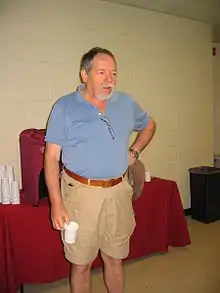Peter J. Freyd | |
|---|---|
 Freyd in 2008 | |
| Born | February 5, 1936 (age 87) Evanston, Illinois, U.S.[1] |
| Alma mater | Princeton University (Ph.D, 1960) |
| Known for | Freyd–Mitchell theorem, HOMFLY polynomial, Allegory (category theory) |
| Scientific career | |
| Fields | Category theory |
| Institutions | University of Pennsylvania |
| Doctoral advisors | Norman Steenrod David Buchsbaum |
Peter John Freyd (/fraɪd/; born February 5, 1936) is an American mathematician, a professor at the University of Pennsylvania, known for work in category theory and for founding the False Memory Syndrome Foundation.
Mathematics
Freyd obtained his Ph.D. from Princeton University in 1960; his dissertation, on Functor Theory,[2] was written under the supervision of Norman Steenrod and David Buchsbaum.
Freyd is best known for his adjoint functor theorem. He was the author of the foundational book Abelian Categories: An Introduction to the Theory of Functors (1964). This work culminates in a proof of the Freyd–Mitchell embedding theorem.
In addition, Freyd's name is associated with the HOMFLYPT polynomial of knot theory, and he and Andre Scedrov originated the concept of (mathematical) allegories.
In 2012, he became a fellow of the American Mathematical Society.[3]
False Memory Syndrome Foundation
Freyd and his wife Pamela founded the False Memory Syndrome Foundation in 1992,[4][5] after Freyd was accused of sexual abuse by his daughter Jennifer.[4][6] Peter Freyd denied the accusations.[7] Three years after its founding, it had more than 7,500 members.[7] As of December 2019, the False Memory Syndrome Foundation was dissolved.[8]
Publications
- Peter Freyd (1964). Abelian Categories: An Introduction to the Theory of Functors. Harper and Row.[9] Reprinted with a forward as "Abelian Categories". Reprints in Theory and Applications of Categories. 3: 23–164. 2003.
- Peter J. Freyd and Andre Scedrov: Categories, Allegories. North-Holland (1999). ISBN 0-444-70368-3.
- Freyd Peter J (1999). "Path Integrals, Bayesian Vision, and Is Gaussian Quadrature Really Good?". Electron. Notes Theor. Comput. Sci. 29: 79. doi:10.1016/S1571-0661(05)80308-1.
- Freyd Peter J.; O'Hearn Peter W.; Power A. John; Takeyama Makoto; Street R.; Tennent Robert D. (1999). "Bireflectivity". Theor. Comput. Sci. 228 (1–2): 49–76. doi:10.1016/S0304-3975(98)00354-5.
References
- ↑ American Men and Women of Science, Thomson Gale, 2005
- ↑ Addison, J.W.; Henkin, Leon; Tarsk, Alfred (2014). The Theory of Models: Proceedings of the 1963 International Symposium at Berkeley. Elsevier. ISBN 9781483275345.
- ↑ List of Fellows of the American Mathematical Society, retrieved 2012-12-29.
- 1 2 Diana E. H. Russell. The Secret Trauma: Incest in the Lives of Girls and Women. Basic Books, 1987. xx–xxi.
- ↑ Sharkey, Joe (June 28, 1998). "Ideas & Trends; Memories Of Wars Never Fought". The New York Times. ISSN 0362-4331. Retrieved January 3, 2020.
- ↑ Freyd, J. (1996) Betrayal Trauma: The Logic of Forgetting Child Abuse. Cambridge, MA: Harvard University Press. The history of the confrontations between the Freyds and their daughter Jennifer is recounted in the Afterword, pages 197–199.
- 1 2 Bor, Jonathan (December 9, 1994). "One family's tragedy spawns national group". Baltimore Sun. Retrieved January 3, 2020.
- ↑ "Survivors Celebrate the End of the False Memory Syndrome Foundation". The Mighty. Retrieved January 2, 2020.
- ↑ Linton, F. E. J. (1965). "Review of Abelian categories: an introduction to the theory of functors by Peter Freyd" (PDF). Bull. Amer. Math. Soc. 71 (4): 577–580. doi:10.1090/s0002-9904-1965-11342-8.
External links
- Peter J. Freyd at the Mathematics Genealogy Project
- Printable versions of Abelian categories, an introduction to the theory of functors.